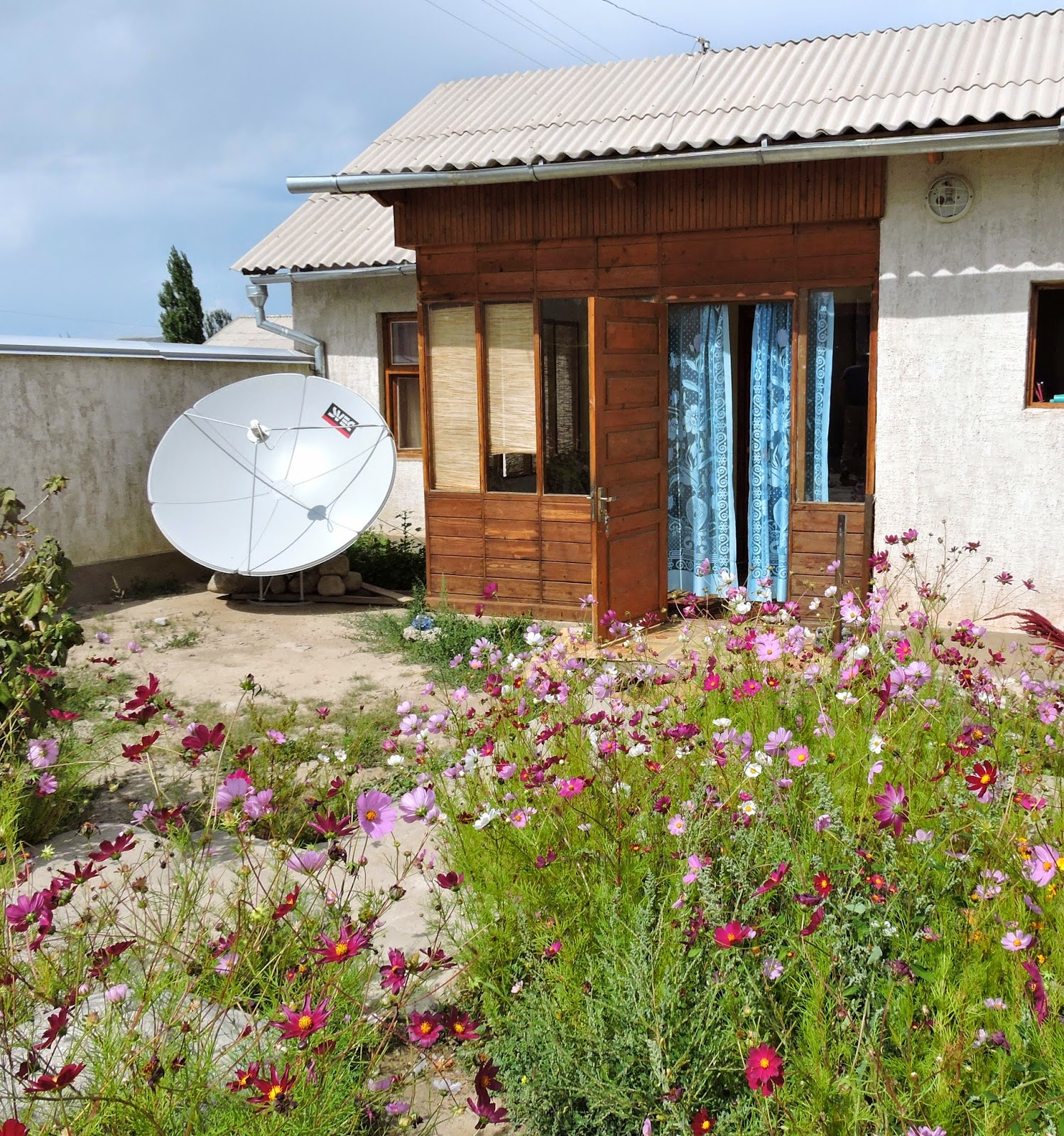 |
| rounds of bread in the bazaar |
 |
| mounds of fruit in thebazaar |
But, get to the Valley, and you traverse cotton fields left over from Soviet days, great mounds of melons on the roadsides (I've never tasted melons like these--pure honey), orchards of pear, apricot, apple and nut trees, and more fields of grains and vegetables. Over 40% of Uzbekistan's population lives here, mostly farmers, but also owners of small shops along the roadsides or in the bazaars.
The main bazaar is full of fruit and mostly women selling foods and handicrafts. Bread is a staple of hospitality and family fare. Hospitality is extremely important in Uzbekistan, so bread is both an offering to guests and a gift to one's host. The bazaar is full of beautifully decorated rounds of bread.
 |
| Don and Gail with university students |
In Kokand, we visited the last Khan's palace with it's small, but interesting, museum, and chatted with university students who giggled over their vain attempts to speak English. Girls and boys both attend the universities, though early marriages usually end the girls' educations. They asked us what age girls married in America and were shocked that many couples are in their 30's before they marry.
The Ferghana Valley has seen a resurgence of handicrafts, with silk weaving being a major activity. We visited a factory to see the process of making hand woven silks fabrics, starting with the cocoon of the silk worm and ending with an array of beautiful silk products for sale. Particularly interesting was the process of tie dying the silk threads, which are amassed into bundles of 2000 to 4000 threads, marked with the pattern to be created, carefully tied, dipped in dyes, retied and redipped over and over until the desired pattern has been achieved.
 |
| silk threads being put on bobbins |
After the dying, a "master" sets up the threads on a loom. This must be done perfectly so that the dyed patterns on the threads align with the pattern the artist has drawn and the fabric can be woven according to the specified pattern.
 |
| marking the bundles of thread |
This weaving workshop also had a factory with mechanized looms that churned out silk fabrics for tie dying as opposed to the threads. The noise was terrible and hurt our ears. I asked our guide about the women who worked inside with no ear protection. He said they get used to it, which I assume means that they slowly go deaf, so aren't so bothered by the noise anymore. Besides, he told us, ear protection is too expensive for Uzbekistan.
 |
| tying the bundles of thread before dying |
We enjoyed lunch in the home of one of the premier silk designers and weavers in the Ferghana Valley. He travels to Santa Fe, New Mexico, each year for the International Craft Fair and has clearly done very well since his home is large, with a huge central courtyard, and houses his entire family of sons, daughters-in-law and grandchildren. Needless to say, we enjoyed buying some more silk textiles from his shop.
 |
| tie dying the bundles of thread |
 |
| setting up the loom |
Another lunch was in a pottery workshop. This potter also takes his beautiful pottery to Santa Fe each year. He has special canvas bags for carrying the larger pieces, which are about 30 inches in diameter. They carry these on their shoulders as cabin baggage. The other, smaller pieces, are carefully packed in huge suitcases and put into the cargo hold. He always sells out in Santa Fe.
 |
| lunch in potter's garden |
Late in the afternoon, we visited a family in their home. There were 4 generations of women (including great-grandbabies) working together on the floor making the thin mattresses families sit on for meals and socializing. These are about 2 inches thick, made of layers of cotton, and covered with a colorful fabric. The women were stitching the mattresses like quilts, with tacks every few inches to hold it all together. When the fabric gets too dirty or has holes, they remove it, carefully clean the cotton and then put it all inside a new cover.
 |
| grandmothers making mattresses |
One of the mothers told us that they were about to have a wedding. They had sold their cow the day before for $1000 in order to buy furniture for the newlyweds. The parents of the bride are responsible for providing furniture. The newlyweds will then move into the groom's parents' home. They were busy with preparations. She told us they would have 1000 guests--yes, 1000. All their families and neighbors would come. The women would sit inside and the men outside, eating plov, the somewhat greasy (with mutton fat) rice, beef and vegetable dish that is a staple of entertaining in
Uzbekistan,. She showed us one of the huge cauldrons they would use to cook the plov.
 |
| 8 pedal silk weaving |
 |
| grandmother and grandchild |
We were welcomed warmly. Everyone wanted to chat and asked us to stay. The great grandmother with no teeth worked and smiled and directed everyone while the bride's mother was busy making wedding arrangements. Neighbors dropped in to talk and ask about us and the wedding. A whole community in one family's courtyard.










































